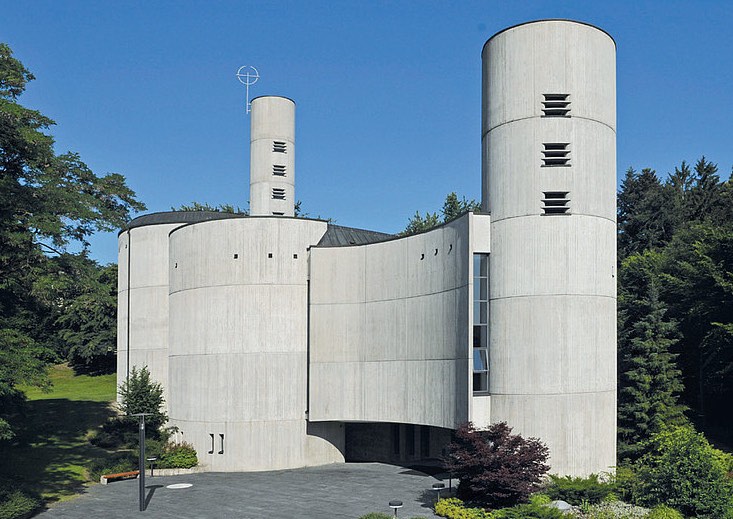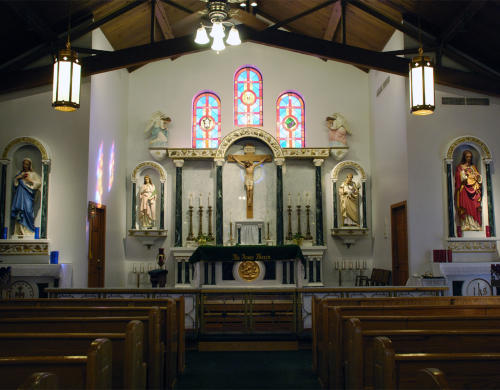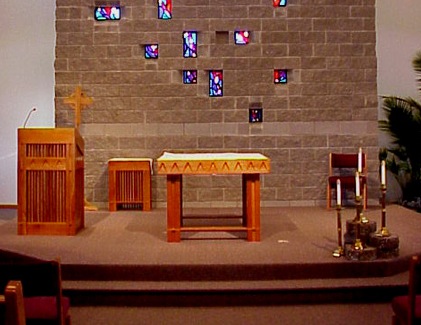More like the devil’s den…
Introducing “God’s Castle”

The eyesore you are looking at above is not a garbage incinerator, a silo complex, or an unfinished nuclear power plant. It is St. Vincent’s “Catholic” Church in Untermarchtal, Germany, part of the notorious Novus Ordo diocese of Rottenburg-Stuttgart, where Mr. Gebhard Fürst presides over the systematic destruction of Catholicism. It serves as the mother church for the St. Vincent de Paul Sisters in the region, who are utterly in love with the building.
Although the building is hideous on the outside, the interior isn’t any better. The following video is in German but it gives a pictorial tour of what’s inside the building. Be careful! You will be subjected to an “altar”, a St. Vincent statue, and a “tabernacle” you won’t be able to un-see:
Construction of this heap of junk lasted from 1970-72. Not surprisingly, the design of this “church” falls into the architectural category called “Brutalism”, which became popular in the post-WWII era. It is truly a brutal attack on man’s innate appreciation of beauty. The name of the architect who perpetrated this is the Swiss Hermann Baur (1894-1980). Other architectural beauties of his can be admired here.
Such a pseudo-Catholic church is not only a problem aesthetically, however, but also — and more importantly — theologically. Church architecture always expresses theology, and for that reason the churches built by the Modernists during and after the Second Vatican Council look strikingly different from real Catholic churches: They are the expression of a new theology, a different faith, especially with regard to the Holy Mass.
For a quick comparison, this is what a Catholic church typically looks like inside:

In the picture above, you see a prominent sanctuary, in which the Sacrifice of the Mass is offered to God by a priest on an altar. All attention is on the tabernacle, always found in the very center of the altar.
By contrast, this is what a Novus Ordo church looks like on the inside:

In that picture, you see a worship space, in which the meal of the Eucharistic celebration is shared with the people by a presider at a table. A tabernacle is nowhere in sight and usually turns out to be an ugly box hidden away on the side somewhere.
Different beliefs — different churches!
With this in mind, we can now take a look at how the Vincentian Sisters interviewed in the clip above justify their love for the Brutalist architecture and the theology it expresses.
The sisters declare that this building is “God’s fortress”, His “castle”, even His “bunker”, and that this “fits into the twentieth century.” The edifice is conducive to “coming to rest”, that is, to being calmed down. We are told that the churches of the Baroque period (of which there are many in the region) needed all sorts of paintings, statues, etc., because the people couldn’t read or write and didn’t understand the Mass, since it was in Latin. Contemporary man, on the other hand, is flooded with images and words all the time and therefore just needs calm and what is essential. (They believe that this travesty of a church provides them with Catholic essentials.) One sister admits that this church could not have been built before Vatican II, and on that she is absolutely right. Finished in 1972, it had actually been in the planning stage since 1966, the first year after the council closed. Noting that the sanctuary with the altar is lower than the nave (where the pews are), one sister explains that this is to show that God humbled Himself when He became man, descending into our world. Thus, so she thinks, this is theologically accurate.
And there we see how much damage Vatican II has done to souls. To dispose ourselves for fruitful prayer, it is indeed important that we become calm and recollected, but that ought not to be done by depriving churches of those things that raise the mind and soul to heavenly things. The sterility and emptiness of Modernist churches can indeed calm one down, but mere calmness must not be the goal. People who practice yoga, for example, are likewise calm but they are opening themselves up to all kinds of danger. “Mind the things that are above, not the things that are upon the earth”, St. Paul says (Col 3:2), and the interior of real Catholic churches is designed to help one do precisely that. Especially in our day, when we are distracted by so many images, it is important to keep the wandering mind focused on God and the things of God. What the ugly church buildings and the corresponding catechesis have done to souls, we need not elaborate on here. Novus Ordos have their entire liturgy in the vernacular, and the people are clueless.
So the “altar” in that church is lower than the pews. That too is in direct contradiction to the traditional practice of putting the altar on a raised platform, with steps leading up to it. Sister’s attempt to justify that on the grounds that God lowered Himself when He came to earth in the Incarnation is specious: The Holy Mass is not the re-enactment of Christ’s lowly Birth in Bethlehem, as though Christ simply wanted to become present again (cf. Denz. 948), but the re-enactment of His Sacrifice on the Cross, which occurred on Mount Calvary, which Christ had to ascend the way Isaac had long before walked up the mountain with wood on his back, in prefiguration of our Blessed Lord’s Sacrifice (see Gen 22:1-12). Christ Himself said, in reference to His Work of Redemption: “And I, if I be lifted up from the earth, will draw all things to myself” (Jn 12:32). What an insult to have people look down upon this Sacrifice rather than up to It. But the Second Vatican Council, of course, and the “liturgical reform” that followed, did away with the Catholic understanding of the Holy Mass, converting it into a Protestant happy meal. Ugly St. Vincent’s Church in Untermarchtal and the Vincentian Sisters happily defending it, are proof of how successful the Modernist revolution has been.
One thing is pretty clear, then: This architectural monster in Germany isn’t God’s castle, or God’s fortress, or God’s bunker.
It’s the devil’s den.
Image sources: germanpostwarmodern.tumblr.com (cropped) / stjosephschurch.net / unknown
Licenses: fair use / fair use / fair use



No Comments
Be the first to start a conversation